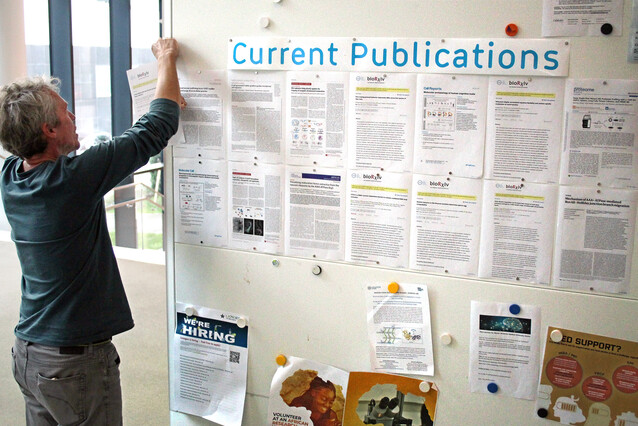A September to remember: unprecedented wave of IMP publications
One month, eight publications – the IMP is riding a wave of discovery into autumn. We look back on the studies that were published in September 2022 and celebrate the institute’s excellent research.
This past month has seen seven of our 15 labs publish at least one of their most recent studies in peer-reviewed journals. This extraordinary wave of publications consisted of eight papers, five of which were published within the same 24 hours.
In the IMP entrance hall, our librarian had to expand the notice board space dedicated to latest publications to fit all of these studies.
“The IMP has always been a place of excellent research and high productivity. However, publication-wise, September 2022 has been one of the most productive months in the institute’s history,” says Scientific Director Jan-Michael Peters. “I am grateful to work in such a dynamic and inspiring environment, where scientists of all career stages get to unleash their scientific curiosity to push the boundaries of knowledge – and share their work with the scientific community.”
To help our readers keep up with our research, we summarised this unusual month in a publication rundown.
Cell biology
In Science Advances, the lab of Andrea Pauli and collaborators report a new and surprisingly simple mechanism to explain how mesodermal cells in the zebra fish embryo migrate during gastrulation. The study, led by PhD student Jessica Stock, explains how a single receptor in mesodermal cells can generate and sense the concentration gradient of Toddler, a chemokine signal that guides migration.
Oliver Hendy, a PhD student in the lab of Alexander Stark, studied how a group of proteins called ‘chromatin remodelers’ change the way DNA is packaged, and how this modulates gene transcription in fruit fly cells. In his latest work, published in the journal Molecular Cell, he found that two major sets of genes require the help of distinct chromatin remodelers to be transcribed.
In a close collaboration with the University of Graz, scientists in the lab of David Haselbach have used cryo-Electron Microscopy to visualise one of the last maturation steps to making a fully functional ribosome in yeast: how the enzyme Drg1 releases a molecular ‘bodyguard’ immediately after exiting the nucleus. They published their findings in the journal Nature Structural and Molecular Biology.
An international team of scientists including the lab of Elly Tanaka has mapped out all cell types in the salamander forebrain. In a colossal effort, they created an atlas of the axolotl forebrain and characterised the cells that give this animal the extraordinary ability to regenerate its neurons after an injury. Their results, alongside two other studies of the salamander brain, were published in the journal Science.
Cancer and immunology
Researchers in the lab of Rushad Pavri have discovered why some cancer-related genes are prone to accidental translocations: during the cell cycle, they replicate at the same time and come closer together, leading to the unwanted chromosome rearrangement. The study, led by Mihaela Peycheva and published in Science, demonstrates for the first time how the timing of replication orchestrates the translocation of tumour-forming genes.
The lab of Johannes Zuber published two of their studies this month. In Blood, Johannes Schmoellerl and Inês Barbosa showed that the oncogene EVI1’s cancer causing effect relies on activating a single gene – the stem cell transcription factor ERG.
In Science, the Zuber Lab and collaborators built on genetic screens to identify the protein LYSET as part of a pathway that allows cancer cells to switch food source when they grow in environments that are low in nutrients. The cancer cells then start using proteins as a food source.
PhD student Theresa Pinter and colleagues in the lab of Meinrad Busslinger screened 3,000 genes and identified novel factors that affect the development of plasmablasts, our first line of defence against pathogens. Their results are published in Frontiers in Immunology.
